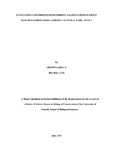| dc.description.abstract | World over, human-carnivore conflicts is among the leading causes in the decline of large
carnivores populations. In Kenya, lions are widely killed by some members of the pastoralist
community due to conflict over livestock. It is therefore necessary to develop mechanisms of
minimizing the conflict. The main objective of this study was to develop an effective lion
entry deterrent system and anti-predator strategy to minimize livestock depredation and
reduce lion mortality arising from retaliatory attacks. The specific objectives were to
determine the densities of available lion prey in the study area, establish the livestock
depredation patterns in the last one year and determine the efficiency of lion entry deterrent
system. The study was carried out in Olgulului and Kimana Group Ranches surrounding
Amboseli National Park. Forty homesteads were selected for the study, twenty from each
ranch. Then, ten homesteads from the ranches were installed with lion entry deterrent system
while the remaining ten were not. Data were collected daily from all the forty homesteads to
determine depredation frequency. A potential prey survey was carried out to determine the
prevalence of lions/preys in the ranches. A binary logistic regression model was used to
assess the efficiency of the LED system. Chi-square and correlation tests were carried out to
determine the association between abundance of predator and prey density in the study areas.
A two-sample t-test was used to assess the difference in the frequency of attacks and
livestock killed in homesteads during the Pre and Post LED period. Results showed that cattle
were the most abundant potential prey, (Mean=64 ±5.4), zebra ranked second (Mean=56
±8.5), while the other prey types comprised of smaller groups of individuals. Further, the
results indicated that hyenas caused over 50% of predatory incidences in both sites (Kimana;
57%, Olgulului; 51%) while the lions were responsible for an average of 25% of the
incidences (Kimana; 24%, Olgulului; 29%). More predatory incidences were recorded during
the wet season than during the dry season. Lastly, homes with LED systems registered low
mean livestock loss which was consistent with high (90%) LED efficiency levels compared
homes without LED systems with low (20%) efficiency level. Thus, once the LED system
was installed, homesteads neighboring wildlife conservation areas experienced fewer
predatory incidences and reduced subsequent retaliatory attacks on large carnivores.
Therefore, if non-lethal methods like lion entry deterrent systems are adopted; poisoning,
snaring and spearing of large carnivores can be minimized. Subsequently, co-existence
between people and carnivores in areas bordering protected conservation areas such as
Amboseli and Nairobi NP can be achieved. | en_US |

